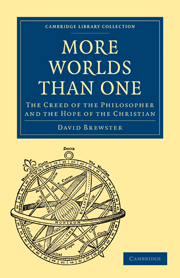Book contents
- Frontmatter
- Contents
- PREFACE
- INTRODUCTION
- CHAP. I Religious Aspect of the Question
- CHAP. II Description of the Solar System
- CHAP. III The Geological Condition of the Earth
- CHAP. IV Analogy between the Earth and the other Planets
- CHAP. V The Sun, Moon, Satellites, and Asteroids
- CHAP. VI The Motion of the Solar System round a distant Centre
- CHAP. VII Religious Difficulties
- CHAP. VIII Single Stars and Binary Systems
- CHAP. IX Clusters of Stars and Nebulæ
- CHAP. X General Summary
- CHAP. XI Reply to Objections drawn from Geology
- CHAP. XII Objections from the Nature of Nebulæ
- CHAP. XIII Objections from the Nature of the Fixed Stars and Binary Systems
- CHAP. XIV Objections from the Nature of the Planets
- CHAP. XV The Future of the Universe
CHAP. II - Description of the Solar System
Published online by Cambridge University Press: 29 August 2010
- Frontmatter
- Contents
- PREFACE
- INTRODUCTION
- CHAP. I Religious Aspect of the Question
- CHAP. II Description of the Solar System
- CHAP. III The Geological Condition of the Earth
- CHAP. IV Analogy between the Earth and the other Planets
- CHAP. V The Sun, Moon, Satellites, and Asteroids
- CHAP. VI The Motion of the Solar System round a distant Centre
- CHAP. VII Religious Difficulties
- CHAP. VIII Single Stars and Binary Systems
- CHAP. IX Clusters of Stars and Nebulæ
- CHAP. X General Summary
- CHAP. XI Reply to Objections drawn from Geology
- CHAP. XII Objections from the Nature of Nebulæ
- CHAP. XIII Objections from the Nature of the Fixed Stars and Binary Systems
- CHAP. XIV Objections from the Nature of the Planets
- CHAP. XV The Future of the Universe
Summary
In order to appreciate the force of the argument for a plurality of worlds, derived from the similarity of our earth, to the other planets of the Solar system, we must call the attention of the reader to a popular description of the magnitudes, distances, and general phenomena of the different bodies that compose it.
In making this survey, the first and the grandest object which arrests our attention is the glorious Sun,—the centre and soul of our system,—the lamp that lights it, the fire that heats it,—the magnet that guides and controls it,—the fountain of colour which gives its azure to the sky, its verdure to the fields, its rainbow hues to the gay world of flowers, and the “purple light of love” to the marble cheek of youth and beauty. This globe, probably of burning gas, enveloping a solid nucleus, is nearly 900,000 miles in diameter, above a hundred times the diameter of our globe, and five hundred times larger in bulk than all the planets put together! It revolves upon its axis in twenty-five days, and throws off its light with the velocity of 192,000 miles in a second. Sometimes by the naked eye, but frequently even by small telescopes, large black spots, many thousand miles in diameter, are seen upon its surface, and are evidently openings in the luminous atmosphere, through which we see the opaque solid nucleus, or the real body of the sun.
- Type
- Chapter
- Information
- More Worlds Than OneThe Creed of the Philosopher and the Hope of the Christian, pp. 21 - 36Publisher: Cambridge University PressPrint publication year: 2009First published in: 1854

